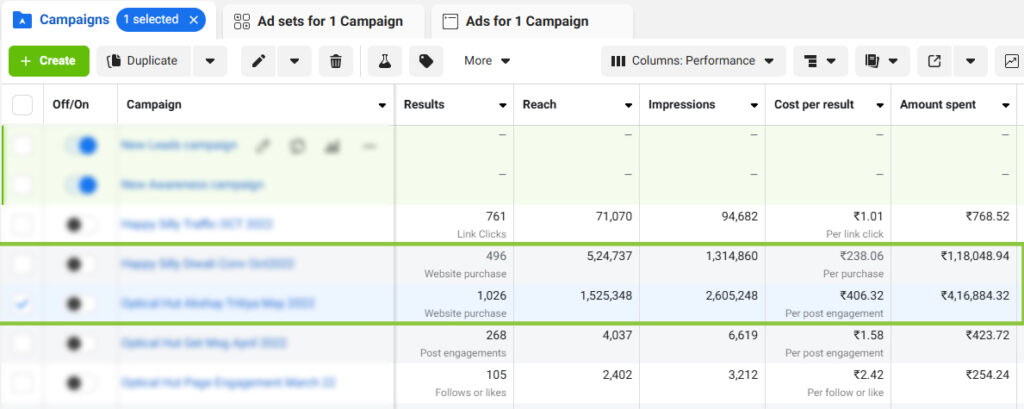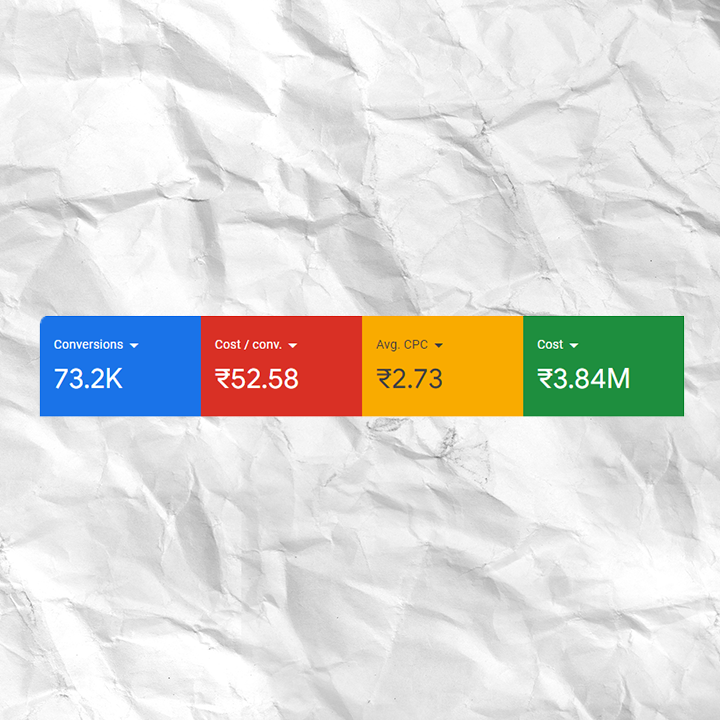
Creating Success for Garmants Brand

Overview of Campaigns
The two campaigns marked in the green box are clearly designed to drive website purchases, a critical objective for any business looking to convert online engagement into sales. These campaigns, identified as First Campaign and Second Campaign, represent significant investments in digital marketing, with each focusing on maximizing reach, impressions, and conversions.
First Campaign Analysis
Campaign Objective:
The primary goal of the First Campaign is to generate website purchases. This suggests that the campaign is targeting users likely to convert after visiting the website, such as existing customers or individuals who have shown a strong interest in the products through previous interactions or browsing behavior.
Key Metrics:
1. Results (Website Purchases):
- Total Purchases: 496
The First Campaign successfully converted 496 users into customers through its advertisements. This metric is crucial as it directly correlates with revenue generated from this campaign.
2. Reach:
- Total Reach: 5,24,737 people
Reach refers to the total number of unique individuals who saw the ads. In this case, over half a million people were exposed to the campaign, which is a substantial audience size, especially for targeted advertising aimed at driving conversions.
3. Impressions:
- Total Impressions: 1,314,860
Impressions represent the total number of times the ads were displayed. This figure is higher than the reach, indicating that some users were exposed to the ads multiple times. High impressions relative to reach often suggest that the ads were being shown to the same users repeatedly, which can be an effective strategy for reinforcing brand messaging and increasing the likelihood of conversion.
4. Cost per Result (Purchase):
- Cost per Purchase: ₹238.06
The cost per result is a critical efficiency metric. At ₹238.06 per purchase, this campaign demonstrates a relatively cost-effective approach to generating sales. This figure is particularly useful for comparing the efficiency of this campaign against others or against industry benchmarks.
5. Total Amount Spent:
- Total Spend: ₹1,18,048.94
The total expenditure for this campaign was ₹1,18,048.94. This budget allocation reflects the level of investment made to achieve the desired number of purchases. The relationship between spend, results, and cost per result provides insights into the overall return on investment (ROI) for this campaign.
Campaign Effectiveness:
The First Campaign’s effectiveness can be assessed by analyzing the interplay between reach, impressions, and conversions. With a reach of 5,24,737 people and 496 conversions, the conversion rate can be calculated as approximately 0.095%, or about 1 in every 1,000 people reached making a purchase. While this might seem low at first glance, it is important to consider the nature of digital advertising where even small conversion rates can lead to significant revenue, particularly in e-commerce settings.
The relatively low cost per purchase of ₹238.06 indicates that the campaign was able to efficiently convert a reasonable percentage of those reached into paying customers. This figure suggests that the targeting was likely well-calibrated, focusing on users who were more likely to convert.
Strategic Implications:
Given the performance of the First Campaign, it’s likely that the strategy involved a mix of retargeting and prospecting. Retargeting users who had previously interacted with the brand or shown intent to purchase could explain the relatively low cost per purchase. Additionally, the use of lookalike audiences—targeting users similar to existing customers—might have helped in reaching a large audience while maintaining a focus on high-intent users.
The budget allocation of ₹1,18,048.94 indicates a moderately aggressive approach to driving sales. The company likely balanced its need for customer acquisition with the cost-efficiency of the campaign, resulting in a campaign that is both expansive in reach and effective in generating sales.
Second Campaign Analysis
Campaign Objective:
Similar to the First Campaign, the Second Campaign was also focused on driving website purchases. However, this campaign appears to have been a larger and more intensive effort, likely tied to a major promotional event or sales period, as suggested by the significant budget and reach.
Key Metrics:
1. Results (Website Purchases):
- Total Purchases: 1,026
The Second Campaign outperformed the First Campaign in terms of raw conversions, generating 1,026 website purchases. This higher number of conversions indicates a successful campaign, particularly in terms of volume.
2. Reach:
- Total Reach: 1,525,348 people
The reach for this campaign is notably larger than that of the First Campaign, at over 1.5 million people. This broader reach suggests that the campaign had a wider targeting scope, possibly including new customer segments or a broader demographic range.
3. Impressions:
- Total Impressions: 2,605,248
With over 2.6 million impressions, this campaign was highly visible, likely due to both a broad reach and a higher frequency of ad exposure. High impressions relative to reach indicate that the ads were served multiple times to the same users, which is a common strategy for increasing brand recall and driving conversions.
4. Cost per Result (Purchase):
- Cost per Purchase: ₹406.32
The cost per purchase for the Second Campaign is significantly higher at ₹406.32 compared to the First Campaign. This higher cost could be due to various factors, including higher competition for ad space, broader targeting, or a more expensive promotional period.
5. Total Amount Spent:
- Total Spend: ₹4,16,884.32
The total spend for this campaign was substantially higher at ₹4,16,884.32. This large budget suggests a major campaign, potentially tied to an important sales event or a strategic push to capture a larger market share.
Campaign Effectiveness:
The Second Campaign was effective in generating a large number of website purchases, with 1,026 conversions. However, the higher cost per purchase suggests that achieving these results required more investment per customer. The broader reach and higher impressions indicate that the campaign was likely aimed at both capturing new customers and driving higher frequency of engagement among existing prospects.
The conversion rate for this campaign, based on the reach, is approximately 0.067%, or about 1 in every 1,500 people reached making a purchase. While this conversion rate is lower than that of the First Campaign, the total number of purchases is higher due to the larger audience.
Strategic Implications:
The higher budget and broader reach of the Second Campaign suggest a more ambitious approach, potentially aimed at capitalizing on a key promotional period or expanding the customer base. The higher cost per purchase indicates that the campaign may have faced more competition or targeted a less responsive audience compared to the First Campaign.
Given the significant investment of ₹4,16,884.32, the campaign likely targeted a mix of new and existing customers. The higher reach and impressions suggest a focus on building brand awareness as well as driving direct conversions. The use of broader audience segments, perhaps through interest-based targeting or broad match lookalikes, might have contributed to the higher cost per purchase.
The decision to invest heavily in this campaign suggests confidence in the potential ROI, possibly due to the higher average order value (AOV) during the promotional period or a strategic push to acquire new customers at scale, even at a higher cost.
Comparative Analysis
When comparing the two campaigns, several key differences and similarities emerge:
1. Budget and Scale:
The Second Campaign had a significantly larger budget and broader reach, indicating a more ambitious scope. This larger scale likely reflects a strategic decision to capture a larger market share or capitalize on a major promotional event.
2. Cost Efficiency:
The First Campaign was more cost-efficient, achieving a lower cost per purchase (₹238.06) compared to the Second Campaign (₹406.32). This suggests that the First Campaign’s targeting was more precise, likely focusing on high-intent users who were more likely to convert.
3. Audience and Reach:
The Second Campaign reached a much larger audience, which likely included a mix of new prospects and existing customers. The broader reach could explain the higher cost per purchase, as the ads were likely served to a more diverse audience with varying levels of purchase intent.
4. Conversion Volume:
Despite the higher cost per purchase, the Second Campaign generated more conversions (1,026 purchases) than the First Campaign (496 purchases). This higher volume could indicate a successful promotional strategy that resonated with a larger segment of the audience.
5. Strategic Goals:
The different approaches in budget allocation, targeting, and scale suggest that the two campaigns had slightly different strategic goals. The First Campaign seems to have been more focused on efficiency and targeting high-intent users, while the Second Campaign likely aimed for broader market penetration and brand awareness.
Recommendations and Future Considerations
1. Balancing Cost and Volume:
The company might consider blending the strategies used in these two campaigns. For example, a phased approach where initial efforts focus on high-intent users (as seen in the First Campaign) could be followed by a broader push (as seen in the Second Campaign) to scale up after initial success. This could help in balancing cost efficiency with volume.
2. Refining Targeting Strategies:
The higher cost per purchase in the Second Campaign suggests there might be room to refine
targeting strategies. This could involve segmenting the audience more effectively or optimizing ad creatives to resonate more strongly with broader audience segments.
3. Budget Allocation:
The substantial investment in the Second Campaign indicates a willingness to spend more to achieve higher volumes. In future campaigns, the company might consider a more segmented budget allocation, where more funds are dedicated to the most effective segments identified during initial phases of the campaign.
4. Long-Term Customer Value:
While the cost per purchase is higher in the Second Campaign, it’s important to consider the long-term value of the customers acquired. If the customers acquired through the Second Campaign have a higher lifetime value, the higher initial cost might be justified.
5. Continuous Optimization:
Both campaigns offer valuable data for future optimizations. Analyzing the performance of different ad sets, creatives, and audience segments can provide insights that inform future campaigns, leading to more effective and cost-efficient advertising efforts.
Conclusion
The two campaigns marked in the green box represent distinct but complementary approaches to digital advertising. The First Campaign, with its focus on cost efficiency and targeted reach, serves as a model for campaigns aimed at high-intent users. The Second Campaign, with its broader reach and larger budget, highlights the potential for scaling up efforts to achieve higher conversion volumes, albeit at a higher cost.
Together, these campaigns demonstrate the importance of strategic planning in digital marketing, where different objectives and audience segments require tailored approaches to maximize return on investment. By analyzing the performance of these campaigns, the company can refine its strategies, improve targeting, and optimize future advertising efforts for even greater success.
You may also be interested
in these projects
Explore other success stories where strategic digital marketing transformed businesses and boosted sales in competitive markets.


